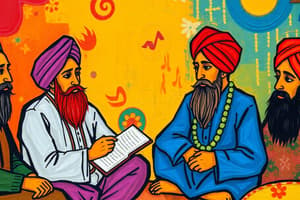Podcast
Questions and Answers
What is the total duration of the course?
What is the total duration of the course?
- 50 hours
- 40 hours
- 30 hours (correct)
- 20 hours
From which units will the short answer questions be formulated?
From which units will the short answer questions be formulated?
- Units 1 and 2 (correct)
- Unit 1 only
- Units 1, 2, and 3
- Unit 2 only
How many short answer questions must students answer from the given set?
How many short answer questions must students answer from the given set?
- 10 out of 12 (correct)
- 5 out of 8
- 8 out of 12
- 15 out of 20
Which of the following is NOT listed as part of Unit I?
Which of the following is NOT listed as part of Unit I?
What is the maximum mark allocation for the written question paper?
What is the maximum mark allocation for the written question paper?
Which folk dance is included in the course content?
Which folk dance is included in the course content?
What is the word limit for each of the compulsory questions?
What is the word limit for each of the compulsory questions?
Which of the following handcrafts is NOT included in the course?
Which of the following handcrafts is NOT included in the course?
Flashcards
Punjabi Language Origin and Evolution
Punjabi Language Origin and Evolution
The Punjabi language, its origins, and how it has developed over time.
Handicrafts
Handicrafts
The practice of creating objects by hand, often passed down through generations, typically using traditional techniques and materials.
Folk Music Instruments
Folk Music Instruments
Musical instruments traditionally used in Punjabi folk music, including the Sarangi, Chimta, and Dhol.
Folk Dances
Folk Dances
Signup and view all the flashcards
Phulkari Embroidery
Phulkari Embroidery
Signup and view all the flashcards
Dari Rugs
Dari Rugs
Signup and view all the flashcards
Chulha Pottery
Chulha Pottery
Signup and view all the flashcards
Study Notes
Punjab's Heritage: Defining Features
- Punjabi Language Heritage: The course focuses on the language's roots, development, and influence.
- Punjabi Folk Arts Heritage: Students will learn about the different types of folk art in Punjab, including embroidery, weaving, and ceramics.
- Punjabi Folk Music Instruments: The course explores traditional Punjabi musical instruments like the Sarangi, Chimta, and Dhol.
- Punjabi Folk Dance Heritage: Focus on the history and cultural significance of traditional folk dances such as Kikli, Gidda, and Bhangra.
Punjab's Heritage: Practical Perspective
- Punjabi Language Origin and Evolution: Students will gain knowledge about the origin and evolution of the Punjabi language.
- Handicrafts: Special attention is given to the techniques and symbolism of Punjabi handicrafts, including Phulkari embroidery, Dari rugs, and Chulha pottery.
- Folk Music Instruments: Further explores the history and significance of folk instruments in Punjab, including the Sarangi, Chimta, and Dhol, highlighting how they contribute to the cultural identity of the region.
- Folk Dances: Continued exploration of the history and performance of Punjabi dances, emphasizing the importance of Kikli, Gidda, and Bhangra in Punjabi culture and traditions.
Assessment and Course Information
- Course Credit: This course is valued at 2 credits.
- Course Duration: Students will spend a total of 30 hours studying this course.
- Total Marks: The final grade is based on a total of 50 marks.
- Internal Assessment: 5 marks are allotted for internal assessments.
- Written Examination: The written examination will hold 45 marks.
- Examination Duration: The examination will last for three hours.
- Short Answer Questions: 20 marks will be awarded for answering short answer questions, with 12 questions provided, students must answer 10.
- Long Answer Questions: 25 marks will be given for completing long-form essays. Students must answer 2 questions from each unit, and they can choose one additional question from either unit. Each essay is worth 5 marks, with a word limit of 150-200 words.
Studying That Suits You
Use AI to generate personalized quizzes and flashcards to suit your learning preferences.




